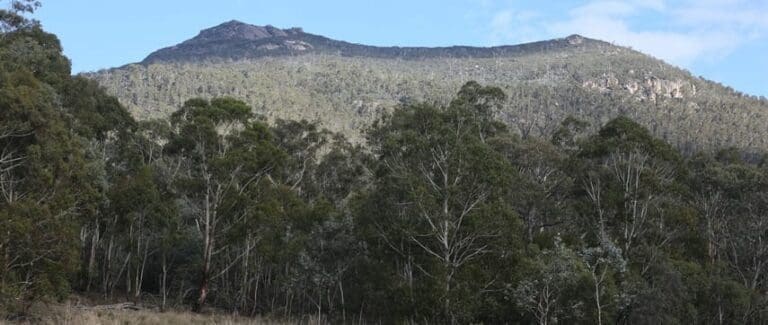Hike at a Glance
Max elevation: 1115m
Min elevation: 957m
Total Ascent: 462m
Hike overview
The Naas Valley to Horse Gully Hut walking track is a moderately difficult (grade 3) 17-kilometre journey within Namadgi National Park. This remote route winds through the Naas Valley, culminating at Horse Gully Hut, and typically takes 7 hours to complete. The track offers a window into the region's rich tapestry of natural history, geological formations, Aboriginal heritage, and pastoral legacy.
The trailhead is located at a locked gate near Mount Clear Campground. Here, you'll find the bushwalking registration log, which must be filled out before setting off. The path follows management fire trails and is shared with cyclists and horse riders. Notably, it also forms part of the Bicentennial National Trail, a vast 5,330-kilometre marked route stretching from Cooktown to Healesville. Be prepared to navigate several creek crossings during your hike.
The Naas Valley walkway presents an opportunity for reflection on the dramatic transformations the landscape has undergone over vast time periods. Geological processes have sculpted the environment, while the vegetation has continually adapted to the changing conditions. Remarkably, geological evidence suggests this area was once an ocean floor some 450 million years ago. Over time, immense heat and pressure transformed these sediments into the present-day sandstones and shales.
Historical evidence suggests the Naas Valley may have served as a pathway for Aboriginal groups travelling eastwards to attend ceremonies in the Gudgenby Valley. If you plan to camp overnight, remember to make a reservation at either Mount Clear Campground or Mount Clear Pound through the Namadgi Visitor Centre.
Gallery
Got some great shots from this hike? Upload your photos here to inspire others and show off the beauty of the trail!
Uploading your photos doesn’t mean you lose ownership. You can be credited for your contributions, and you can request removal at any time.
Content use
Please don’t copy GPX files or content from this site to AllTrails or other platforms. Each trail has been personally mapped, documented, and refined to support Australia’s bushwalking and hiking community. While some details come from land managers, every listing reflects significant personal effort. This is a free, community-driven initiative—your respect helps keep it that way.
Walk map and GPX file
Max elevation: 1115 m
Min elevation: 957 m
Total climbing: 462 m
Total descent: -459 m
Getting there
Getting to the trailhead: Namadgi National Park.
Accessing the Naas Valley to Horse Gully Hut trailhead requires reaching Mount Clear Campground. This remote location lies roughly 44.5 kilometres from the Namadgi Visitor Centre. The initial leg of the journey follows Naas Road and Boboyan Road, transitioning to unsealed gravel after approximately 36 kilometres. While the road is generally suitable for two-wheel drive vehicles, weather conditions can impact its usability. For the most up-to-date information on road closures or hazards, contact the Namadgi Visitor Centre before your trip. Upon arrival at Mount Clear Campground, locate the locked gate near the camping area. Remember to fill out the bushwalking registration log before commencing your hike on the Naas Valley track.
Closest towns to this walk: Banks, Canberra, Conder, Cotter River, Gordon, Hall, Jerrabomberra, Kambah, Lanyon, Michelago, Narrabundah, O'Malley, Pearce, Queanbeyan, Tharwa, Tidbinbilla, Tuggeranong, Tumut, Uriarra, Uriarra Village, Wanniassa, Watson, Weston Creek, Woden
About the region
The Namadgi National Park lies on Ngunnawal Country. This land, rich in cultural significance, has been managed by the Ngunnawal people for countless generations. Their deep connection to this landscape encompasses cultural, social, environmental, spiritual and economic aspects.
Encompassing over 106,000 hectares, Namadgi National Park safeguards a vast area of alpine, sub-alpine and mountain bushland. Nearly half of the Australian Capital Territory falls within its boundaries. The park is crucial for the preservation of high-altitude sphagnum bogs. These bogs provide critical habitat for endangered species and act as natural reservoirs, slowly releasing clean water that sustains the ACT.
For visitor information, maps, firewood permits, or general inquiries, head to the Namadgi Visitor Centre.
Hikers will find hundreds of kilometres of trails to explore within Namadgi National Park. Before venturing out, it's important to familiarise yourself with the Australian Walking Track Grading System. Additionally, inform someone of your planned route and estimated return time. Be sure to record your trip details in the designated bushwalking registers located throughout the park. Straying from marked trails is only recommended for experienced navigators with proper map and compass skills. As weather conditions in the mountains can change rapidly year-round, always pack warm and waterproof clothing.
Namadgi National Park is home to numerous significant Ngunnawal cultural sites and objects scattered across the landscape. These include the Yankee Hat Rock Art and other locations that hold stories of vital knowledge, cultural values, and wisdom. These sites are deeply important to the Ngunnawal people. Their history is not only documented in archaeological finds but also preserved in the landscape itself, passed down through generations through oral stories, dance, memory, ceremonies and the artistic depictions found in rock art sites.
The Ngunnawal people emphasise the importance of protecting these stories, sites and objects for future generations. Visitors to Namadgi are asked to treat these locations with respect, recognising them as a rich and ancient part of the park's narrative.
Similar walks nearby
Looking for more walks in or near Namadgi National Park? Try these trails with a similar difficulty grade.
Track grade
Grade 3 (Moderate) - Walks for Most Fitness Levels: Grade 3 on the AWTGS represents moderate walking tracks. These are ideal for walkers with some fitness who are comfortable with some hills and uneven terrain. While suitable for most ages, some bushwalking experience is recommended to ensure a safe and enjoyable experience. Tracks may have short, steep hill sections, a rough surface, and many steps. The total distance of a Grade 3 walk can be up to 20 kilometers.
Explore safe
Plan ahead and hike safely! Carry enough water, pack layers for changing conditions, and bring safety gear like a torch, PLB, and reliable communication device. Check official sources for trail updates, closures, and access requirements, and review local weather and bushfire advice. Most importantly, share your plans with someone before you go. Being prepared makes for a safer and more enjoyable hike! Stay Safe, Explore More, and Always #ExploreSafe.
Packing checklists
What you carry in your pack depends on factors like weather, terrain, and your adventure type. Not sure what to bring? My free planning, food, and packing checklists are a great starting point, covering day hikes, overnight trips, and multi-day adventures. Use them to customise your kit and always prioritise safety.
Let someone know
Before heading out, take a moment to fill out your trip intentions form. It’s a quick way to share your hike details with family or friends. If something goes wrong, they can notify emergency services, ensuring a faster response and peace of mind. Stay safe and enjoy your adventure
Suggest an edit
Spotted a change on this trail? Maybe there are new features, the route has shifted, or the trail is permanently closed. Whatever the update, I’d love your input. Your feedback helps fellow hikers stay informed and ensures that our trail info stays fresh and reliable.
Acknowledgement of Country
Trail Hiking Australia acknowledges the Traditional Owners of the lands on which we hike and pay respects to their Elders, past and present, and we acknowledge the First Nations people of other communities who may be here today.






